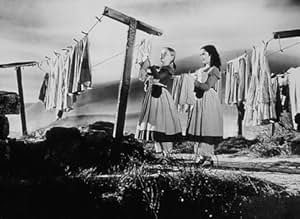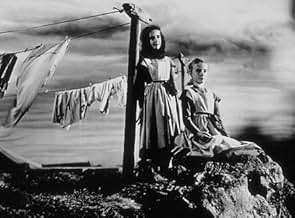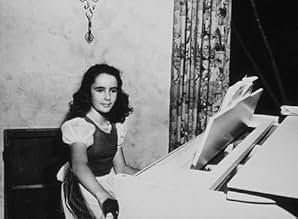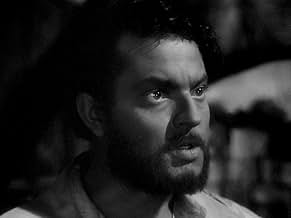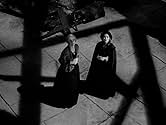Jane Eyre
- 1943
- Tous publics
- 1h 37m
After a harsh childhood, orphan Jane Eyre is hired by Edward Rochester, the brooding lord of a mysterious manor house, to care for his young daughter.After a harsh childhood, orphan Jane Eyre is hired by Edward Rochester, the brooding lord of a mysterious manor house, to care for his young daughter.After a harsh childhood, orphan Jane Eyre is hired by Edward Rochester, the brooding lord of a mysterious manor house, to care for his young daughter.
- Awards
- 3 wins total
- Mason
- (uncredited)
- Guard
- (uncredited)
- Bookie
- (uncredited)
- Townsman
- (uncredited)
- Woman at Party
- (uncredited)
- Proprietor
- (uncredited)
Featured reviews
After a harsh and eye opening childhood, orphan Jane Eyre gains employment at Thornfield Hall as governess to the young ward of Edward Rochester. A Difference in class and life outlook, Jane and Rochester are by definition polar opposites, but a bond exists, a bond that surely can't conquer the mysteries of Rochester the man, and the secret of his estate - can it?
Stevenson's version of the often filmed Jane Eyre has been pored over numerous times before, the constant question that arises is that of just how much input and work did Orson Welles have in the production? Knowing what we now know of Welles' 40s output, Jane Eyre undeniably has the Wellesian stamp all over it, with Fontaine herself quoted as saying the big man was often found behind the camera. This is not to decry Stevenson in any way, he himself would carve out a good career in directing further down the line, but this take on Brontë's famous novel shines because of Welles' presence in front and behind the camera.
With that comes one of only two quibbles with the film as a whole, namely it's Welles' portrayal of Rochester that dominates the film, and not that of Fontaine's Eyre. Which is quite staggering considering he doesn't enter the fray until 34 minutes into ty epic. The other problem, naturally, is that with a running time of just over an hour and thirty five minutes, it was never going to be a detailed adaptation of the novel. However, what exists is still an excellent mounted production, a film pulsing with aggressive atmospherics and simmering emotional passions.
It has been argued that the opposing acting styles of Fontaine and Welles are a distraction, I don't see it that way at all, as one of classic cinemas greatest voices emotionally spars with one of its most beautiful faces, this is monochrome gold dust. In mind of the difference of characters as written on the page, it actually comes off as inspired casting. With the production that surrounds them perfectly in keeping with the characters' state of mind.
The look is assuredly what would become known as film noir, with George Barnes' (Rebecca/Spellbound/Force of Evil) vivid black and white photography dovetailing splendidly with the matte paintings and Gothic set designs. It still amazes me to this day that this film was entirely produced on stage 2 at 20th Century Fox. So many images burn into the memory. From the shards of shadows that accompany young Jane as she stands on the punishment stool at Lowood Institution, put there by the despotic Henry Brocklehurst (a menacing Henry Daniell), to each chiaroscuro lit composition of Rochester in and around the oppressive like family home, the film has visual moodiness in abundance.
Herrmann's (The Devil and Daniel Webster/Citizen Kane) score is crucially in tune as well. Orchestral swirls to portray Jane's longing are counter pointed by the menacing down beats that attack the viewer for Rochester's bluster. Away from the two leads it's young Peggy Ann Garner who delivers the most telling performance. She gives the child version of Jane a sorrowful edge that sets the tone of the film, her early scenes with an uncredited Elizabeth Taylor (beautiful and effectively correct in vocals) are a lesson in child acting. The rest of the cast is filled out with admirable performances from Margaret O'Brien (Meet Me in St. Louis), John Sutton (Captain from Castille), Sara Allgood (The Lodger) and Agnes Moorehead (The Magnificent Ambersons).
This may not be a definitive Jane Eyre adaptation, and the compromised ending does knock it down a point, but all told it's still a top piece of classic cinema. 9/10
Under Robert Stevenson's direction Fontaine/Welles seem to capture the essence of two abused outsiders resisting their attraction for one another, trying to adhere to convention. A strong supporting cast. There are brief though memorable appearances by Agnes Moorehead, Elizabeth Taylor and Peggy Ann Garner as "young" Jane.
George Barnes' camera captures appropriately stark images of Ross Dowd and Thomas Little's sets. Charlotte Bronte's grim novel is well suited to the excellent B/W, cinematography: a memorable scene early in the film has young Jane being punished by being forced to stand on a stool that is nearly in the center of a fan of shadows cast by the stair railing, It is almost reminiscent of expressionist German films of the Weimar years.
The film manages to entertain as well as inform. Purists may object to the last 3 lines of the film which hint at a slightly happier denouement than the book offered. In spite of that, Jane Eyre is still a nearly flawless film.
There are a lot of fine actors in the cast, and Orson Welles is ideal for the role of Rochester. Joan Fontaine is good too as (the adult) Jane, although the character in this version is somewhat less interesting than in the novel, so she has less to work with than Welles does. There are some fine performances in the early part of the movie, and some excellent casting, including Agnes Moorehead as Jane's mean-spirited aunt, the icy Henry Daniell as Brocklehurst, and a young Elizabeth Taylor as Jane's school friend Helen. That part of the film works perfectly.
Although the last part is not quite as effective, overall the movie still offers several good reasons to watch it. You get to see a fine cast in action, and if the film is not the masterpiece that the novel was, it's a good picture and certainly worth seeing.
Did you know
- TriviaAfter securing the screen rights, David O. Selznick originally approached Orson Welles to play the role of Rochester opposite Selznick contractee Joan Fontaine. He got Aldous Huxley, John Houseman, and Robert Stevenson involved. Ultimately though, he sold the package to Darryl F. Zanuck and Twentieth Century Fox.
- GoofsThe text of "Jane Eyre, Chapter 1" that appears on screen does not correspond to the text of Bronte's novel. Chapter 1 actually opens, "There was no possibility of taking a walk that day. We had been wandering, indeed, in the leafless shrubbery an hour in the morning; but since dinner (Mrs. Reed, when there was no company, dined early) the cold winter wind had brought with it clouds so sombre, and a rain so penetrating, that further out-door exercise was now out of the question."
- Quotes
[first lines]
Jane Eyre: [narrating] My name is Jane Eyre... I was born in 1820, a harsh time of change in England. Money and position seemed all that mattered. Charity was a cold and disagreeable word. Religion too often wore a mask of bigotry and cruelty. There was no proper place for the poor or the unfortunate. I had no father or mother, brother or sister. As a child I lived with my aunt, Mrs. Reed of Gateshead Hall. I do not remember that she ever spoke one kind word to me.
- Alternate versionsThere is an Italian edition of this film on DVD, distributed by DNA srl, "JANE EYRE (1943) + LETTER FROM AN UNKNOWN WOMAN (1948)" (2 Films on a single DVD), re-edited with the contribution of film historian Riccardo Cusin. This version is also available for streaming on some platforms.
- ConnectionsFeatured in AFI Life Achievement Award: A Tribute to Orson Welles (1975)
Details
- Release date
- Country of origin
- Official site
- Language
- Also known as
- Alma rebelde
- Filming locations
- Production company
- See more company credits at IMDbPro
Box office
- Budget
- $1,705,000 (estimated)
- Runtime1 hour 37 minutes
- Color
- Aspect ratio
- 1.37 : 1


